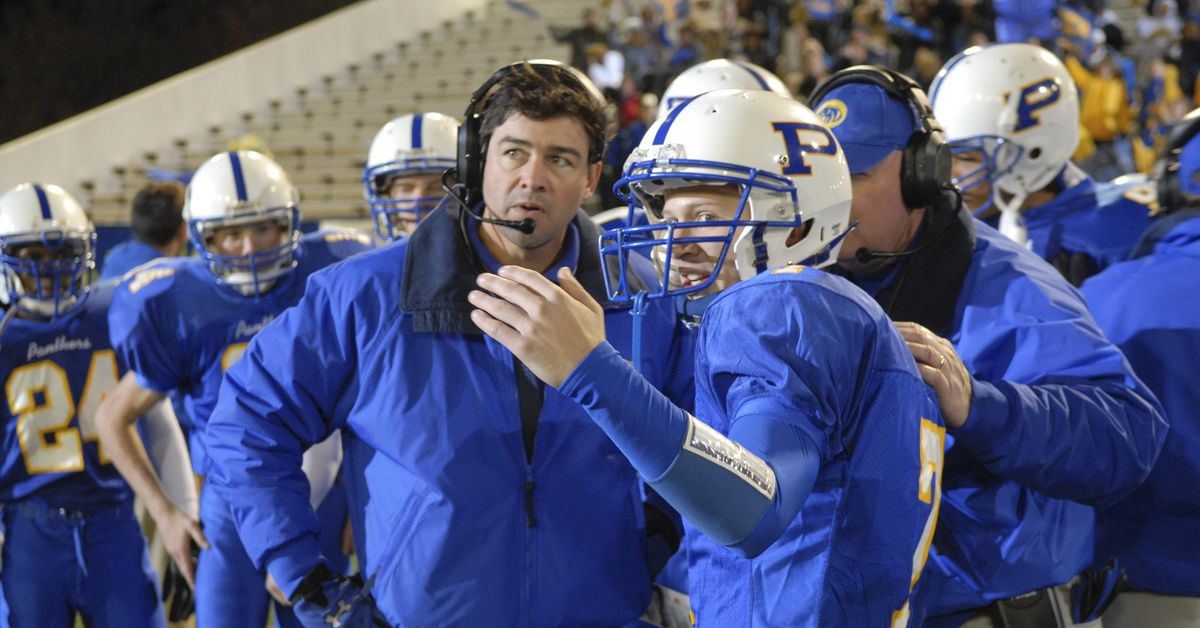
Jason Katims, the showrunner of Friday Night Lights, knew he had to be judicious when it came to deploying his show’s most famous catchphrase.
The catchphrase, of course, is “Clear eyes, full hearts, can’t lose,” a rallying cry that unites first the Dillon Panthers high school football team and then the East Dillon Lions team in the series, which ran from 2006 to 2011. And good news both for FNL fans and those who have yet to check out one of the best teen dramas of all time — all 76 episodes of the series are back on Netflix for your streaming pleasure.
Of all of the elements this stellar series gave the world, perhaps none is as durable as “Clear eyes, full hearts, can’t lose.” It’s what you say when your back is against the wall, and you don’t know what’s coming next, but you know your friends are beside you. And maybe that will be enough. That idea has resonated with a lot of people. Even Barack Obama has quoted it.
The first use of “Clear eyes” is in the series’ pilot, written by Peter Berg, but when it came time for Katims to take on the actual running of the show for the 75 episodes that followed, he and the writers opted to keep the catchphrase on the very back burner. They knew when they needed it, it would be there for them. And it always, always worked.
“You had to find those moments that were big and not use it in every episode and use it all of the time,” Katims said when I interviewed him in 2018. “That makes it iconic in a way. Look, it’s the words. It’s Kyle Chandler saying those words. It’s the faces of those players repeating them back to him. It’s a combination of all of those things.”
There are many, many reasons to recommend FNL, but having a great catchphrase that never outstays its welcome is pretty remarkable. How many other TV shows have managed that? What marks that catchphrase as a truly fantastic bit of writing is just how much “Clear eyes, full hearts, can’t lose” reflects so many other elements that make this show worth recommending.
For instance, consider the series’ tone, which is unique in TV history. Most small-town series offer up quirky wonderlands you might want to move to yourself. (Think: Gilmore Girls, Schitt’s Creek.) Most teen dramas are about either the sexy complications of the hottest teens imaginable (think: Gossip Girl, 90210) or the weirdos and wannabes always watching those hotties and grousing about it (think: Freaks and Geeks, Veronica Mars). And when it comes to TV sports dramas … well, before FNL, TV hadn’t really done many sports dramas.
What Friday Night Lights accomplished tonally is hugely impressive. Dillon, Texas, feels like a real place, complete with all the stresses that would exist in a small West Texas town, but it never goes so far into its realism that it becomes despairing. Its teenagers have sexy complications and sometimes complain about the hotter teens around them, but they never feel defined by their confidence or their awkwardness. They’re just teens, fumbling through life and occasionally doing the right thing.
The series’ depiction of high school football is also deeply influential on a host of TV dramas that followed. You don’t have to know a thing about football to enjoy the show. (Honestly, if you know too much about football, you might roll your eyes at how many games are won on last-second plays.) But you do have to know about a town where everybody cares about one tiny thing as though their lives depend on it. Dillon, Texas, loves high school football almost as much as it loves God or America. Whether you love the team or simply don’t care about it ends up being almost a political statement.
My “grew up in a small town in the Midwest where high school sports were a big, big deal” is showing here, but: I don’t know that any TV show has quite captured what adolescence is really like as well as Friday Night Lights. Much of that can be attributed to the actors, a terrific collection of then-up-and-coming performers who included everybody from Michael B. Jordan to Jurnee Smollett, from Taylor Kitsch to Zach Gilford. (Hollywood has never quite figured out how to use Gilford’s “aw shucks” Jimmy Stewart energy since FNL ended, but that energy is turned up to 11 in the role of unlikely quarterback hero Matt Saracen.)
This show isn’t just about the teens, either. It’s also one of the best TV portrayals of the ins and outs of a long, successful marriage. As Eric and Tami Taylor, Kyle Chandler and Connie Britton are pitch-perfect as two people who love each other dearly and sometimes best express that by bickering affectionately with each other. The secret sauce that makes FNL work is that it’s sneakily a family drama, where the Taylors are father and mother to a whole host of teens whose lives cross paths with theirs. Is Coach Taylor the original Ted Lasso? I’m not going to say that, but you might!
I will not sit here and tell you that Friday Night Lights is perfect. It very much is not. The second season, in particular, has some disastrous storylines, one of which actually involves a character committing murder. However, that season ends strong, and in a marathon watch, the bad stuff will be over before you know it.
The other four seasons are all astonishingly good, and the series finale is one of the best in TV history (and one of the few where I don’t mind an ending that leaves no room for ambiguity). Chandler and Katims won Emmys for their work on that final season, and those awards were richly deserved.
Whether you’ve never seen it or just want to watch it again, Friday Night Lights is the perfect late-summer TV treat. Soon enough, high school football fields all over the country will glow as dusk settles at the end of another long week. Off the field, the problems of the world remain. But on the field, they can be put off for a few hours every week. Clear eyes, full hearts, you know the rest.
Friday Night Lights is streaming on Netflix. It is 76 episodes, most around 45 minutes in length.
For more recommendations from the world of culture, check out the One Good Thing archives.






